-

Long newspaper article with a handwritten notation above in ink stating "Newport News Va. Press. Mar 31-07" Article details the Jamestown Tercentennial - exhibitions had been all set up for April opening. Art and objects were scattered around the fairgrounds and housed within eight buildings. Meta is mentioned half way through the right column of the article. "Another feature of the exposition that will attract attention is a series of illuminated tableaux showing the progress of the negro race. An agreement has been entered into between the executive committee designated by the general government to prepare the negro exhibit for the Jamestown Tercentennial Exposition and Meta Vauz(sic.) Warrick, of Philadelphia, a young negro woman who is a sculptor of some repute by which the latter is to furnish those tableaux, illustrating the history of the negro race from the landing of the first boat load of African slaves on the James river, in 1619 to the present day. __ planned, by the construction of appropriate models, dramatic groupings, and the use of suitable scenic accessories, to trace in chronologic order the progress of the negro people in all the arts of civilization. There will be '15 model groups, each of the basic dimensions of ten feet long and ten feet wide, the figures to be one fourth life sixe(sic.), making in all an exhibit covering more than 1,500 square feet of floor space."
-
Newspaper article in four sections. Newspaper title is in two skinny strips on either side of the main article, which states "Public Ledger - Philadelphia. Sunday Morning, April 14, 1907" The article is as follow: "Negro Artist Busy With Historic Task/Woman's Work Will Show Progress of Race Since the Landing at Jamestown./Government Contract/150 Figures, in 15 Groups, to Occupy Prominent Position at Exposition. Working from early morning until a late hour each night, a young negro artist, Meta Vaux Warrick, is endeavoring to complete 150 figures, representing the progress of her race from the time of the landing at Jamestown, Va., in 1619 to the present day. The figures are classified in 15 groups and are being made for the United States Government. They will occupy a prominent position in the Negro Building at Jamestown Exposition. The Artist's contract with the Government calls for the completion of the work by May 10. Property backgrounds, ten feet by ten feet, are now being painted in the artist's studio at 210 South Camac street, simultaneously with her work upon the figures, which are to be one-fourth life size. Classified groups and figures are: First. Landing at jamestown: Twenty slaves, five white men. Properties, scenery showing sea, ship, sky and landing; towers, houses and landscape. Figures, 25. Second. Negroes working in a cotton field. Properties, wagon, cotton, baskets. Figures, 10. Third. Slaves escaping, followed by two white men and a bloodhound - the negro hiding behind a clump of bushes and trees, water indicating he has crossed a stream and evaded pursuers on the opposite side. Properties, bushes and trees. Figures, 4. Fourth. Allen beginning the African Methodist Episcopal Church - Negroes worshiping in a blacksmith shop. Properties, anvil, books and furnace. Figures, 8. Fifth. Negro soldiers taking "The Order of the Day." Properties, guns and trees. Figures, 9. Sixth. Negroes protecting white women and children during the Civil War - A tramp soldier attempting to steal a white child; mother about to faint; a negress attendant at her side; a negro attacking the tramp to protect the child. Properties, chair, grass, flowers, trees and scenery. Figures, 5. Seventh. Negroes staring out after their emancipation - Man, homeless, surrounded by his family. Properties, bushes and trees. Figures, 6. Eighth. Negro schoolhouse - Children on their way to school. Properties, schoolhouse, books and trees. Figures, 15. Ninth. Negro farmer gathering his crops. Properties, house, crops and (start of second article) basket, Figures, 5. Tenth. Negro mechanic at work upon an unfinished building. Properties, lumber, house and tools. Figures, 4. Eleventh. Negro banker - interior of the bank, showing tellers or clerks and a depositor. Properties, books, money, desk and papers. Figures, 4. Twelfth. Negro church - Negroes about to enter the building. Properties, scenery, etc. Figures, 15. Thirteenth. Negro at home surrounded by his family; reading to his wife, who is doing embroidery and listening to the story; children playing and listening. Properties, rugs, tables, chairs and pictures on walls. Figures, 6. Fourteenth. Section A - Paul Laurence Dunbar writing verses. Properties, table, tablecloth, chair, pictures, couch and cushions. Figure, 1. Section B - Tanner painting from the model. Properties, easel, canvas, seats and drapery. Figures 2. Section C - Physician operating; nurses in attendance. Properties, stretcher, table, instruments and sheets. Figures, 4. Section D - Douglass delivering an oration. Properties, platform, table, pitcher, benches or chairs; scenery representing part of audence. Figures, 10. Fifteenth - Wilberforce community; students in caps and gowns, representing commencement day. Properties, trees, grass and scenery, including buildings, Figures, 18. Educated in Philadelphia This artist has been at work for several weeks on this task, and is liable to the infliction of penalties by the Government in the form of fines if the work is not completed by the contract date. She received her education in the public schools of Philadelphia and was awarded a scholarship to the School of Industrial Art of the Pennsylvania Museum, where she remained for five years, taking three prizes, among which were the first prize for metalwork design in 1898, and the first prize for modeling in 1899. She has exhibited in the Salon and has held two private exhibitions, one here and the other in Paris, where she studied under several noted men for three years. Her work is most instances has tended toward the gruesome, some of her notable figures being "The Man Eating His Heart Out," which personified loneliness; a second, "Oedipus Tearing His Eyes Out," and a third, "The Thief on the Cross," the latter showing the victim's horrible suffering. Interested in the Gruesome. Discussing this trend of her sculptural work, she said yesterday: 'Since the time I was a child here in Philadelphia, where I was born and have grown up, the gruesome phases of life have interested me. It was not that I searched for it, but simply that it came to mind. I had the habit of imagining the most horrible things and reciting them to my family as if they had actually happened to me. Many times I scared them badly. I suppose there are some who might say that I have a diseased mind.' She laughed heartily at this, and then told of a thought that occurred to her a few days ago with much relish as recalling her youthful fancies. 'It grew out of the murder case in New York and the use of the alienist term 'brain storm,'' she said. 'Remembering what awful pictures my mind conjured up at that time, I wondered and sought to answer my own inquiry whether the prisoner of the present trial ever was the victim of such imaginings as filled my childish head.' No member of her family, according to Miss Warrick, ever showed artistic talent, except a sister, who did not pursue her work beyond the initial stages. The young artist lives at 206 South Twelfth street.
-
Newspaper article with the title "At the Whitehouse". The article is as follows: "Negro Exhibits at the Jamestown Exposition./Creditable to the Race/Decided to Arrange Them All by States./Mr. Knox's Unruly Auto/Would not go Because the Water Had Frozen, and He Went to Capitol in a Street Car. President Roosevelt was told today that the negro exhibits in the negro building at Jamestown will be both creditable to the race and the nation. The progress that has been made by the Negro Development Company in preparing for the exhibition that will be made by the race was laid before the President by the officials of the company, consisting of Giles H. Jackson of Virginia, director general; Mrs. A. M. Curtis of this city, Thomas J. Galloway, Tennessee; Andrew F. Hillyer, Arthur L. Macbeth, Robert Kelser, C. N. Johnson, J. M. May, William Hope, C. H. Williamson, D. E. N. Campbell, Arnold Hill, Miss Meta Warrick, F. D. Lee.
-

Newspaper article with a handwritten notation in ink down the left side "N.Y. Lun__ Mar 31, 1907." The article is as follows: " A Negro Sculptress/ Miss Warrick Appointed by Government to Send Exhibit to Jamestown./ An unusual interest attaches to the appointment by the United States government of Miss Meta Vaux Warrick as sculptress for the Negro exhibit at the Jamestown Exposition. The appointment is an honor to her sex and an honor to her race, and it is safe to say that many visitors to the exposition will make a point of seeing what this young Negro woman can do. Miss Warrick's plans for the decoration of the Negro Pavillion include a series of fifteen tableaus, illustrating the history of the Negro race from the landing of the first boatload of African slaves at Jamestown in 1619 to the present time. Each group will occupy a square measuring ten feet by ten, (follows on second clipping) the figure being a quarter life size, and the whole series will cover 1,500 feet of space. After the landing of the slaves at Jamestown, the Negroes will be shown at work in the cotton field. There will be shown the escaping slave, and side by side with the Negro soldier will stand the faithful protector of the family of the absent master. In other models will be shown the Negro as farmer, mechanic and banker, the Negro poet, the orator, the painter and the physician. The thirst of the Negro race for knowledge and enlightenment (broken up by a round photograph of Meta and the text "Miss Meta Vaux Warrick./ Sculptress of the Negro exhibit at the Jamestown Exposition.") will be reflected by the primitive schoolhouse, and the handsome modern church will be contrasted with the first African Methodist Episcopal Church founded at Philadelphia, in 1816, by Richard Allen. Miss Warrick was educated in the Drexed (word crossed out in ink) School of Fine arts in Philadelphia, of which city she is a native, and she has also studied in Paris."
-
Newspaper article in two sections with the title "Colored Sculptor's Honor" with a photograph of Meta in her studio. The article is as follows: "Meta Warrick to Furnish Tableaux for Jamestown Exposition. Miss Meta Vaux Warrick, of this city, a colored sculptor of high repute, is to furnish a series of illuminated tableaux for the Jamestown Exposition. Illustrative of the history of the negro race from the landing of the first boatload of African slaves on the Jamestown River in 1619 to the present day. It is Miss Warrick's plan to show by the construction of appropriate models, dramatic groupings and the use of suitable scenic accessories, to trace in chronological order the progress of teh negro people in all the arts of civilization. There will be fifteen model groups, each of the basic dimensions for ten feet long and ten feet wide, making in all an exhibit covering more than 1500 feet of floor space."
-
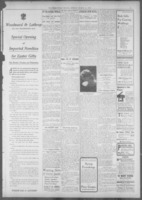
Newspaper article from "The Washington Herald, Monday, March 18, 1907" with the title "Negro Tableaux Planned." Article is as follows: "Progress of Race to Be Demonstrated at Jamestown Exhibition. An agreement has been entered into between the executive committee designated by the general government to be prepare the negro exhibit for the Jamestown Ter-Centennial Exposition and Miss Meta Vaux Warrick, of Philadelphia, a sculptor of international repute, by which the latter is to furnish a series of illuminated tableaux illustrative of the history of the negro race from landing of the first boat load of African slaves on the James River, in 1619, to the present day. It is Miss Warrick's plan to show by the construction of appropriate models, dramatic groupings, and the use of suitable scenic accessories, to trace in chronological order the progress of the negro people in all the arts of civilization. There will be fifteen model groups, each of the basic dimentions of ten feet long by ten feet wide, the figures to be one-forth life size, making in all an exhibit covering more than 1,500 square feet of floor space. Miss Meta Vaux Warrick is a young colored woman of unusual intelligence. Her education was acquired in the Drexel School of Fine Arts, in Philadelphia, of which city she is a native. She has taken supplementary courses in several of the leading art institutes in Paris, France."
-
Short newspaper article with handwritten notation above in black ink "Phila. Press/ Feb 1906". Article is as follows: "Advance in Sculpture./ The sculpture of the exhibition measures one of those great advances sometimes apparent in a single year." The article goes to list a number of artists. Meta is mentioned just below the middle of the article: "..., and has also some examples of delicious genre, one, "The Wind" (1015), Miss Meta Warrick has an auto-portrait in bronze (1017) of somber force..."
-
Small pamphlet with the headline "Art Lecture on Paris/by/Miss Meta Vaux Warrick, of Philadelphia. Front lists the program of the following: "Introduction of Miss Warrick, U.S.J. Dunbar, Sculptor/Art and Life in Paris,...Miss Warrick/Tenor Solo,...Mr. Wormley./Piano Solo,...Miss Europe./Demonstration of Sculpture,...Miss Warrick." Below the program lists the officers and teachers of the Berean Church and Sunday School. Inside the pamphlet lists those who helped fund this lecture, listing two pages full of supporters. The back page lists a biography of Miss Warrick and a list of works which includes "The Wretched, The Thief on the Cross, John the Baptist, Peeping Tom, Sylvia, Secret Suffering, Death in the Wind, Silenus, Falstaff, The Man who Laughed' and several African sculpture types. Behind this is a very small newspaper article, which states "The Art Lecture of Miss Meta Vaux Warrick of Philadelphia, under the auspices of the Berean Sunday school on Wednesday night was highly enjoyed by a large and representative audience. The patrons numbered more than 150 of Washington's art lovers. Miss Warrick, after graduating from the School of Industrial Art in Philadelphia, studied three years in Paris."
-
Small newspaper article with bold black lettering. Article is as follows: "A rare treat is in store for those who attend the lecture to be given by Miss Meta Vaux Warrick at Berean Church the 17th of May. The lecture will be illustrated and more than a dozen examples of her work will be shown and explianed to the audience. Miss Warrick will tell in her own inimitable way of life in the French Capital, where she spent three years, and had showed upon her encomiums from the greatest art critics in the world. Here is one from Gustave Coquit, a famous critic of Paris: 'You will be struck in this gallery with the attractive works of Mlle. Warrick, her grasp of grouping, and her characteristic capacity for interpreting life.' You should not miss Miss Warrick's lecture next month, for you are sure to be highly entertained and instructed."
-
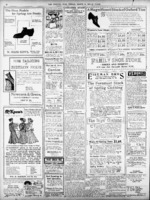
Small newspaper article with a handwritten note below it in pencil stating "Washington 4-31-05". The article is as follows: "Miss Warrick Lectures on Art. Art Ideals and student Life in the French Captial was the subject of an interesting lecture yesterday evening by Miss Meta Vaux Warrick the sculptor, who recentlly returned from Paris and who is at present a member of the board of control of the Alumni Association of the Pennsylvania Museum of Art. The talk was before a number of prominent citizens who had been invited by Mesdames Hilyer, Pelham and Gray to meet the artist at a drawing-room reception. For an hour Miss Warrick entertained the company with an account of her Parisian experiences, and at the conclusion of her discourse gave a demonstration of her methods of work, a mass of clay, under he deft fingers rapidly assuming form and finally disclosing the characteristic lines and features of a kind-faced old man."
-
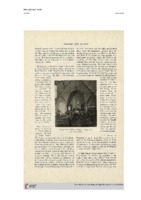
Magazine article with a photograph of 'Brittany Peasant' in the lower right. In pencil next to the article is written 'International Studio/April 1905'. The article is as follows: "At the School of Industrial Art, Broad and Pine Streets, Philadelphia, an exhibition of the work of Miss Meta Vaux Warrick was recently held under the auspices of the Alumni Association. Miss Warrick is of negro blood. After studying at the School of Industrial Art for five years, she went to Paris in 1899 where the next three years was spend in study under such masters as Collin, Carles, Injalbert and Rodin. From the latter she got much sympahty and encouragement, and her work shows his influence profoundly. As in Rodin's work, so in Miss Warrick's, strength of conception and vividness of imagination, combined with a passion for realism, are the paramount features. There was hardly a piece in the exhibition that did not depict some serious idea: some scene or phase of suffering; sometimes even a bald expression of something unpleasant, but very real. It leads one to theorize that her work is the (perhaps unconscious) expression of the trials and sorrows of a once oppressed race. The strength of feeling and the depth of insight behind the work, and the broad, almost coarse, touch of the artist that does not mince matters, but goes straight to the spot, are such as to compel attention and to deamnd careful consideration. Besides sculpture, Miss Warrick exhibited several pieces of pottery, distinguished by breadth of treatment and a distinctly sculptural treatment of the ornament."
-

Newspaper article in ten section across three pages of the scrapbook. Above the article written in pencil is "Eagle - Brooklyn N.F. Feb. 12 - 1905". Headline is "Themes in Sculpture Earn Fame in France and America for a Colored Girl". Article follows in three columns. Below the columns on the second page is a large image of "Silenus." with two small cropped newspaper articles on the lower corners. The left states "...only at the Ecole des Beaux Arts under M. Injalbert. Parisians eagerly sought the strange and...". The clipping on the right states "...weird productions of the colored girl. With success won and money coming in freely, Miss Warwick decided to return to her native..." On the third page is a large photograph of "Eating His Heart Out" and a photograph of Meta working on a bust with the caption "Meta Vaux Warwick, Chief Exponent of Horrors in Sculpture." The third small clipping states "...land and city and test the taste of her compatriots for the virile creations of her strange imagination. She has so far succeeded in creating a decided sensation." Main body of article is as follows: "In this era of originality what can be said of the sculpturess who breaks away from tradition and, instead of the beautiful, depicts only the horrors of life? Her work must of necessity attract attention. When the master of Paris approved of the departure it must be admired that a new cult is about to be born. Miss Meta Vaux Warwick, whose exhibition at the School of Industrial Art in Philadelphia is attracting crowds on that institution, has dared to model a figure that shall depict the man who is popularly said to be "eating his heart out." This weird conception so attracted the attention of Rodin in Paris that he declared the sculptress was a new power in the art world. The points that impressed the master in this pathetic figure of suffering were, first of all, the outline, which viewed from any point is forceful; the sweep of the back that interprets through the face and hands, and its intense humanity. To the laymen the figure, like vice, first repels then attracts. It is grewsome, but compelling; shocking, but holding the attention with magnetic force. Another remarkable figure in the exhibition represents Oedipus, who, according to the Greek legend tore out his eyes after discovering that he had wedded his own mother. This story Miss Warwick has portrayed in a figure of such appalling horror that the spectator stands spell bound. The despair of the sightless cauntenance that is turned upward no words can describe. And yet there is a beauty all its own in the terrible trouble of the face and figure. (From here to end crossed out in pencil) When Rodin saw this figure he looked at is first in amazement and line, after studying it a while said to Miss Warwick, 'My Child, you are a sculptor." "Death in a Wind Storm" is the title Miss Warwick had given to the figure of a skeleton swathed in wraps blown by the wind. He is moving forward with a set purpose. Thrown out in the cold and the wet and the wind he grins to himself for he knowns that no storm can beat him down and no cold rain chill his fleshless bones. "Primative woman" is another strange conception. The catlike crouching figure is repulsive in its animal like apsect, beautiful in the strong impression of materialism that the creation gives when the child by the side of the creeping figure is viewed with it. "Silenus" is another example of Miss Warwick's fearlessness in defying convention. The old god is represented by his true colors as the son of 'Pan'. Drunk himself, he is carried by a faun and satyr shuffling, staggering and in attitudes calculated to shock a fastidious public. Falstaff is an entirely new figure to Shakespearean scholars. He is not so rotund as the popular conception and is depicted laughing in drunken glee and carrying one of his boots in his hand. The expression of the face is a clever portrayal of the mood of the man. This Falstaff is pretty sure to become a standard conception of the jovial man of wine and words. But the conceptions are not all of this nightmare variety. Miss Warwick has done a few things that can be viewed without shuddering. One of the best of these is "An Old Peasant Woman', in which Miss Warwick has caught what Millet, above all painters, has caught in "The Sower." There is, too, the bend of toil, the clumsy trudge of the wayfarer, the earth-grimed mark of years. As a whole, the exhibition impels one to marvel shudderingly at the depth of thought of this young girl. A group called 'The Wretched' represents those afflicted by incapability, physical malady and melancholy. Asked why the subjects of the world's most pathetic ills should have been selected by her for portrayal, Miss Warwick replied: "It is only those who have been through great suffering themselves who can see a positive beauty in suffering." Which epigrammatical sentiment may perhaps become the text of the sermon of future volaries of this new cult. It will be still more astonishing to those who watch the rise of a new figure in the art world to learn that this girl who thus depicts suffering and wretched in gems of the sculptor's art is a colored girl, with a touch of Indian blood in her veins. Her mother is a Philadelphian, her father a Virginian. She is 27 years of age. She won a scholarship in one of the grammar schools which entitled her to a three-year course at the School of Industrial Art in Philadelphia. Her work here was extended to a further two years in the normal and postgraduate departments, at the end of which time, with all the honors in the power of her alma mater to confer, Miss Warwick sailed for Paris in the autumn of 1899. In the French capital she studied drawing for the first half year under Raphael Collin, the figure painter, and for the second worked under M. Carles. Then followed a twelvemonth at the Academic Colarossi and lectures on anat-..."
-
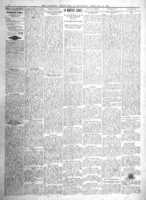
Three clipped newspaper articles from "The Gazette, Cleveland, O., " dated "Saturday, February 11, 1905" Article is as follows: "Meta Vaux Warwick, "My Child, You Are a Sculptor," Said the Great Master, Rodin, to One of Our Girls. Philadelphia, Pa. - Miss Meta Vaux Warwick's[sic] exhibition of sculpture at the School of Industrial Art, in the rooms of the Alumni association, under whose auspices the exhibition was held, was closed to the public on the 4th, said a local daily paper recently.
Miss Warwick is of the race that has given to the world Henry Tanner, Paul Laurence Dunbar and Charles Waddell Chesnutt. She is of pure Negro blood as far back as the fourth generation, her grandfather at that removed being a Caucasian. Her mother is a Philadelphian, her father, born in Virginia, is a Philadelphian by adoption, and Miss Warwick herself was born here 27 years ago.
To the public schools of this city is due the credit of Miss Warwick's first art impulse. Mr. J. Liberty Tadd instructed her before she entered her teens, and a scholarship from the grammar school at Twelfth and Locust streets secured her three years' instruction at the School of Industrial Art. Her work here was extended for a further two years in the normal and post graduate departments, at the end of which time, with all the honors in the power of her alma mater to confer, Miss Warwick sailed for Paris in the autumn of 1899.
In the French capital she studied drawing for the first half year under Raphael Collin, the figure painter, and for the second worked in modeling under M. Charles. Then followed a twelve month at the Academie Colarossi and lectures on anatomy at the Ecole des Beaux Arts under M. Injalbert. One day Miss Warwick took a bit of plaster, not eight inches high, to Rodin. After turning it around in silence, the master at last touched the young girl's shoulder and said: 'My child, you are a sculptor.' For a year after this Miss Warwick's work passed before the eyes of the great French realist.
The present exhibition is a work of great importance, not because Miss Warwick is the only sculptor of her race or because she is one of that group of gifted ones who, from the embers of oppression, poverty, ignorance and caste exclusion are rising, and by the simple force of individual excellence, claiming the respect and admiration of their fairer countrymen; the exhibition is remarkable on its own account. Never before, certainly not in Philadelphia, has such a showing been made. This is not saying that Miss Warwick is our greatest sculptor. She may and she may not be."
-
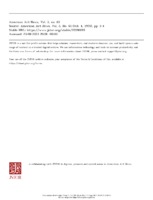
Typed list of works, number and divided into types. A few on the second page have checkmarks in pencil by the works. At the end glued to the last page of the list is an article from the "American Art News, New York, February 4th, 1905". Article is as follows: "At the Philadelphia School of Industrial Art there is an interesting exhibition of sclupture[sic.], portrait busts and figurines, the work of Meta Vaux Warrick, a young colored woman with a strain of white blood. The work is extremely individual, showing a morbid, strong imagination and the influence of Rodin, who has taken great interest in her progress. The exhibition will continue for another week." List is as follows: "Catalogue. 1. Portrait of the late William Still 2. Head - John the Baptist 3. Peeping Tom 4. Sylvia 5. Portrait study from mirrors. 6. Portrait from Memory of the late William Thomas Sketches 7. The Man Eating his Heart 8. Falstaff 9. Study of Expression 10. Oriental Dancer 11. Wrestlers 12. Death in the Wind 13. Despair 14. The Man with a Thorn 15. The Man who Laughed. 16. The Two-step 17. Brittany Vendeuse 18. Silenus 19. OEdipus 20. McKinley Monument 21. Primitive Woman 22. Wild Fire (Start of page 2) Studies of Afro-American Types 23. An Old Woman 24. A School-boy 25. The Comedian 26. Danny Deever (The Student) 27. The Artist 28. Mulatto Child. Fragments 29. Cyclops 30. " 31. Dancing Woman 32. Study of Pose. 33. The Bear-trap 34. Primitive Man 35. Medusa 36. The Cloud 37. The British Lion 38. Procession of Arts & Crafts (Start of Page 3) Photographs 1. John 2. Man Eating his Heart 3. Silenus 4. OEdipus 5. The Street Dancer 6. Study of a Man 7. Primitive Woman 8. Impenitant Thief 9. Three Gray Women 10. Man Carrying a Dead Body."
-
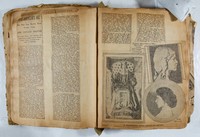
Long newspaper article over two pages of the scrapbook. Header is "Philadelphia, Sunday, February 5" and date is broken off, but must be 1905 as the article overall is about her exhibition at the School of Industrial Art. Article includes three photographs, one profile of Meta, one of her dressed in Greek costume, and one of her bust of Sylvia. Full transcription is saved on the server.
-
Small newspaper article stating: "Sculptured work by Miss Meta Vaux Warrick will be put on view at the School of Industrial Art, Broad and Pine streets, to-morrow afternoon at 4 o'clock and remain on view daily, except Sunday, from noon to 5 P.M. The display is one of those arranged by the Alumni Association of the institution in question."
-
Small newspaper article with pencil notation on top "S Press /29/95" and beneath "January 29th" stating: "Miss Meta Vaux Warrick, continues at the School of Industrial Art, Broad and Pine, for another week her unique and interesting exhibition of her work in sculpture and in decorative pottery. Extending from her student work, through the brilliant and suggestive studies in Paris, to the careful portrait busts now occupying her, the room fully reveals a remarkable personality and unusual achievement."
-
Small newspaper article stating: "The exhibition of Meta Vaux Warrick is still on view at the School of Industrial Art, at Broad and Pine streets."
-
Newspaper article with the headline "the Evening Star/Saturday, January 21, 1905". The text is as follows: "Miss Warwick's Success in Sculpture. Considerable attention is being given in Philadelphia this week to Miss Meta Vaux Warrick's exhibition of sculpture. Miss Warwick is the sister-in-law of F. L. Cardozo, supervising principal of the thirteenth division, colored, of the Washington public schools. She has made her name stand for the highest things in art, and is regarded as on a plane with Henry Tanner, Paul Lawrence Dunbar and other prominent members of her race. Her work is described as a little below the average in technique, but of unusual strength. In her choice of original themes she is said to be remarkable. Never before has such a showing been made in Philadelphia, according to an art critic of that city."
-

Article with headline "American Art News" and the text "The sculptural work of Meta Vaux Watn [sic] will continue on view at the School of Industrial Art, Broad and Fine Streets, Philadelphia, until Feb. 4 every day except Sunday from noon until 5 o'clock." Below this is "New York, January 21st, 1905."
-
Newspaper article with headline "Art and Artists" with pencil notation above "Public Ledger" and to the left side "Sun Jan 17" Article is as follows: "A significant group of statuettes, portrait busts and studies, as well as a number of examples of pottery, the work of the interesting young sculptor, Meta Vaux Warrick, was exhibited for the first time yesterday afternoon at the School of Industrial Art, at Broad and Pine streets, where it will remain on view for three weeks. It is only possible here to indicate briefly the importance of this small group of work, which is characterized by a breadth of conception and a vividness of imagination that make it poarticularly noteworthy. Except to the few who have been following the trend of modern artistic expression, the collection may prove generally disagreeable. There is not a "pretty" thing in the room, if we except some of the pottery, and as very few of the works shown are more than sketches, the exhibition will probably make but a small appeal to the general public. That Miss Warrick is a very close student of the human anatomy is at once apparent, and while her statues are not "finished", in the accepted sense of the term, one of them is lacking in its suggestion of a definite idea expressed. Crude and rough they may be, but each one (some more successful than others) is evidently the result of profound thought. They display a mentality far above the ordinary and all bear the imporit of the artist's unusaul personality. As pure negro blood runs in Miss Warrick's veins, her achievement, viewed in the light of accepted standards, is the more remarkable. After having been graduated from the Art School here, she went to Paris in 1899, where she studied drawing for the first half year under Raphael Collin, the figure painter, and later modeling, under Carles. For a year she worked at the Academie Colarossi and attended lectures on anatomy at the Ecole des Beaux Arts under Injalbert. Her work was approved by Rodin, whose influence it shows in a marked degree. There is nothing in the present exhibition which is not a concrete expression of thought or of some metaphysical truth which the suffering of the world has suggested to the mind of the sculptor. It is not an agreeable exhibition, but it is a very compelling one."
-
Newspaper article in five sections across two pages of the scrapbook. In pencil above in cursive is written "Philadelphia Press" and beneath that between the first two sections of article is "1/15/05". The article is a detailed write up of her exhibiton at the Pennsylvania Museum and School of Industrial Art. Next to the last section of the article is a handwritten name "Elizabeth Dunbar" on a separate piece of paper - maybe the person who cut out and sent her the article? The overall article is long and a full transcription can be found on the server.
-
Newspaper article in three sections. Header is separate and states "Ossining, N Y., Monday September 12, 1904." The article is in two sections and is as follows: "A Distinguished Visitor. The Sculptor, Miss Meta Wan Warrick, of Philadelphia, Pa., is in town visiting Mr. and Mrs. Peter Parker, and her friend, Mrs. J. W. Hoffman, Jr., of Durston Avenue. The following is one of the many articles written in reference to Miss Van Warrick's work both here and abroad: 'Several American women have won fame in the field of sculpture, and one of the most noted is the young mulatto girl, Miss Meta Van Warrick, whose work is creating much comment on both sides of the sea. Miss Warrick is the sculptor whose masterly expression of strange and original thoughts led the celebrated Rodin to give her special attention during the three years she spent studying in Paris. 'This young woman has known all the hardships and struggles of lonely student life in the great French City, and while she struggled wrought her emotions into her work, which is expressive of the despair which often overtook her. However, success was near. when she was scarely nineteen years of age she took one of her models to Rodin. He recognized the genius in her handiwork, and from that time on hse was his protege. 'One of the finest pieces of her work, "The Wretched," so attracted the attention of M. Bing, the great Art Connoissseur of Paris, that he had it cast in bronze. Art loving Paris was amazed at this example of the young girl's work, of which it has been said that, 'the orignal conception, the movement of palpitating life, the masterly grouping, would be remarkable for a mature man." 'Miss Warrick has a great field open to her, and every promise of being able to fill it to the satisfaction of her fellow artists. She won the first prize, $25.00 for a jardiniere in June, 1904, being also a student in Pottery. 'Miss Warrick is Philadelphia born and bred, and at the School of Industrial Art she received the education and encouragement necessary to send her to Paris to study, and, after her return home, the first public recognition of the Art World, for she is now on the Alumni Board of Control. 'In her studio, 210 South Camac Street, Philadelphia, Pa., Miss Warrick works from sunrise to sunset. Her studio is her world, and the figures her fingers have modeled into form are her companions. She has finished life-sized statues as well as busts, groups as well as single figures, and in every instance her work has been bold and free in outline. 'Two of her works "The Thief on the Cross" and "The Wretched" have been exhibited at the Paris Salon of 1903. 'This is a list of subjects nearly completed by Miss Warrick: "The Violist," "Mother and Child", "Portrait of the Sculptor", "The Sphinx." 'The following are subjects about to be worked up by the sculptor: "Prospective," "The Young Devil," "Studies of Colored Children," "Fire."
-
Newspaper article with large image of a sculpture and a small article pasted besides. Image has the text beneath "'The Wretched' One of Miss Warrick's Weird Bits of Statuary (Women Sculptors Challenging Fame.) The article is as follows: "One could not think of using the old term 'sculptress' in speaking of Meta Vaux Warrick, the young Philadelphia mulatto girl whose work has reated a future both in this country and abroad. She is a Philadelphian born and bread, and at the School of Industrial Art she received the education and encouragement necessary to send her to Paris to study, and, after her return home, the first public recognition of the art world, for she is now on the School Board of Control. She has known all the harships of lonely young student life in the great French city, and much of her work was expressive of her despair. When she was scarely 19 she took one of her models to Rodin, and from that time on she was his special protege. One of the finest pieces of work, "The Wretched," M. Bing, the great French sculptor, had cast in bronze, and artistic Paris was amazed at the work - the originating life, the masterly grouping would be remarkable for a mature man."
-
Newspaper article in two sections. Title is 'Craftsmen's Work in Four Exhibits/ School of Industrial Art Has Largest Collection on View at the Handicrafters Have Smallest, But in Point of Excellence the Best - News of the Studio'. Article goes into several exhibitions around Philadelphia. Meta is mentioned at the very end: "...The few pieces of sculpture in the exhibition are quite noticeably above the average of work usually seen at schools. The exhibitors are Miss Meta Vaux Warrick and Mr. Salvador Belotti, both of whom are showing portrait busts. Miss Warrick exhibits also some of her small figure compositions, which express with much dramatic force certain abstract ideas."










